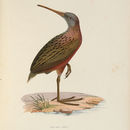Conservation Status
provided by Afrotropical Birds LifeDesk
Description
provided by Afrotropical Birds LifeDesk
Endemic, medium-sized plain brown rail.
Diagnostic Description
provided by Afrotropical Birds LifeDesk
Long, slender bill, lack of white in throat, unbarred flanks and upperpart colouration
Distribution
provided by Afrotropical Birds LifeDesk
Habitat
provided by Afrotropical Birds LifeDesk
Marshes and wet margins especially high altitude
Movements and dispersal
provided by Afrotropical Birds LifeDesk
Biology
provided by Arkive
The Madagascar rail is a solitary bird, preferring to stay hidden amongst the dense wetland vegetation. Indeed, often the only indicator of the Madagascar rail's presence is its loud call, klee killee klee, made during the daytime to attract a mate (4) (5). Breeding generally occurs from August to October, with the nest constructed on the ground, hidden amongst the wetland plants (2).
The Madagascar rail's diet mainly consists of invertebrates found within the muddy wetland sediment, which are extracted using its long, curved bill (2) (4).
Conservation
provided by Arkive
While there are no specific conservation measures in place at present, the Madagascar rail does occur in a number of protected areas. Nevertheless, significant portions of this species' range remain unprotected, and threatened by habitat loss and degradation (2). The BirdLife International partnership is working to conserve the valuable, biodiverse wetlands of Madagascar, so far, focussing their efforts on important wetland areas in western Madagascar. However, it is likely that conservation efforts will also be directed towards the eastern wetlands in the future (7).
Description
provided by Arkive
Found only in the wetlands of eastern Madagascar, the Madagascar rail is a secretive bird that is rarely found in the open (3) (4). Its plumage is mostly plain brown on the body, with some dark streaks on the upperparts and upper breast, and grey on the face and throat. This rather drab colouring is somewhat enlivened by its dark red bill and legs, white undertail (2), and purple underparts (4).
Habitat
provided by Arkive
A wetland species, the Madagascar rail occupies areas of dense, aquatic vegetation such as marshes, wet woodlands and the margins of rivers. It can be found at a range of altitudes, from sea level to elevations of up to 1,800 metres (2).
Range
provided by Arkive
The Madagascar rail is endemic to Madagascar, where it is distributed throughout the east side of the island (4)
Status
provided by Arkive
Classified as Vulnerable (VU) on the IUCN Red List (1).
Threats
provided by Arkive
The main threat to the Madagascar rail is the loss of its wetland habitat as a result of logging and conversion to agriculture (2). Many marshland sites in eastern Madagascar have been converted to rice fields, increasing sediment and reducing the natural vegetation that this species relies upon (6). In 2002, its population was estimated to be between 2,500 and 10,000 individuals, and it is currently believed to be declining, although further surveys are required to determine how rapidly (2).
Madagascar rail
provided by wikipedia EN
- license
- cc-by-sa-3.0
- copyright
- Wikipedia authors and editors
Madagascar rail: Brief Summary
provided by wikipedia EN
The Madagascar rail (Rallus madagascariensis) is a species of bird in the family Rallidae.
It is endemic to Madagascar.
- license
- cc-by-sa-3.0
- copyright
- Wikipedia authors and editors

